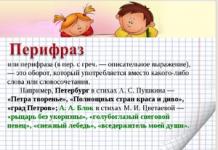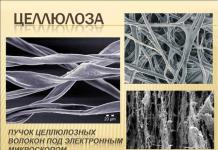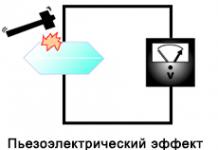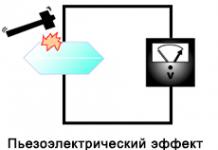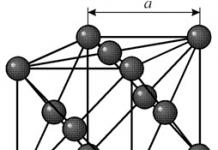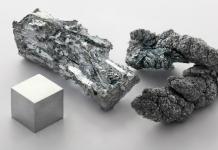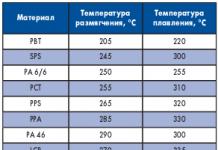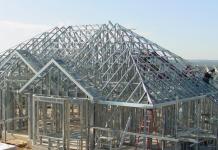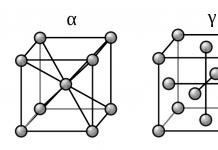ELEMENTS VI A subgroups
(O, S, Se, Te, Po)
Oxygen
Sulfur
Selenium and tellurium
General characteristics of the elements
The VI A subgroup of PS includes the elements: oxygen, sulfur, selenium, tellurium and polonium. For sulfur, selenium, tellurium and polonium, a common name is used - chalcogens. Oxygen, sulfur, selenium and tellurium are non-metals, while polonium is a metal. Polonium is a radioactive element, in nature it is formed in small quantities during the radioactive decay of radium, therefore its chemical properties are poorly studied.
Table 1
Main characteristics of chalcogens
| Characteristics | O | S | Se | Those |
| Atomic radius, nm | 0,066 | 0,104 | 0,117 | 0,136 |
| Ionic radius E 2-, nm | 0,140 | 0,184 | 0,198 | 0,221 |
| Ionization potential, eV | 13,62 | 10,36 | 9,75 | 9,01 |
| Electron affinity, eV | 1,47 | 2,08 | 2,02 | 1,96 |
| Electronegativity (according to Pauling) | 3,44 | 2,58 | 2,55 | 2,10 |
| Bond enthalpy, kJ/mol E –E E = E | - 146 - 494 | - 265 - 421 | - 192 - 272 | - 218 - 126 |
| Melting point, °С | ||||
| Boiling point, °C | - 183 | |||
| Density, g / cm 3 | 1.43 (liquid) | 2,07 | 4,80 | 6,33 |
| Content in earth's crust, % (wt.) | 49,13 | 0,003 | 1.4 10 -5 | 1 10 -7 |
| Mass numbers of natural isotopes | 16, 17, 18 | 32, 33, 34, 35 | 74, 76, 77, 78, 80, 82 | 120, 122, 123, 124, 125, 126 128, 130 |
| The state of aggregation at Art. conditions of the most stable allotropic form. Colour | colorless gas | Crystal. yellow substance | Crystal. gray matter | Crystal. silvery white substance |
| Crystal cell | Molecular in TV. form | molecular | molecular | molecular |
| Composition of molecules | About 2 | S8 | Se ∞ | Te ∞ |
According to the structure of the outer electronic layer, the considered elements belong to the p-elements. Of the six electrons in the outer layer, two are unpaired, which determines their valence of two. For atoms of sulfur, selenium, tellurium and polonium in an excited state, the number of unpaired electrons can be 4 and 6. That is, these elements can be four - and hexavalent. All elements have high electronegativity values, and the EO of oxygen is second only to fluorine. Therefore, in compounds they exhibit art. oxidation -2, -1, 0. The ionization potentials of sulfur, selenium and tellurium atoms are small, and these elements in compounds with halogens have oxidation states of +4 and +6. Oxygen has a positive oxidation state in fluorine compounds and in ozone.
Atoms can form molecules with a double bond O 2, ... and join in chains E - E - ... - E -, which can exist both in simple and in complex substances. In terms of chemical activity and oxidizing ability, chalcogens are inferior to halogens. This is indicated by the fact that in nature oxygen and sulfur exist not only in a bound, but also in a free state. The lower activity of chalcogens is largely due to a stronger bond in the molecules. In general, chalcogens are among the highly reactive substances, the activity of which sharply increases with increasing temperature. Allotropic modifications are known for all substances of this subgroup. Sulfur and oxygen electricity practically do not conduct (dielectrics), selenium and tellurium are semiconductors.
When moving from oxygen to tellurium, the tendency of elements to form double bonds with small atoms (C, N, O) decreases. The inability of large atoms to form π-bonds with oxygen is especially evident in the case of tellurium. So, in tellurium there are no acid molecules H 2 TeO 3 and H 2 TeO 4 (meta-forms), as well as TeO 2 molecules. Tellurium dioxide exists only in the form of a polymer, where all oxygen atoms are bridging: Te - O - Te. Telluric acid, unlike sulfuric and selenic acid, occurs only in the ortho form - H 6 TeO 6, where, as in TeO 2, the Te atoms are connected to the O atoms only by σ-bonds.
The chemical properties of oxygen differ from those of sulfur, selenium and tellurium. On the contrary, there is much in common in the properties of sulfur, selenium and tellurium. When moving through the group from top to bottom, an increase in acidic and reducing properties in the series of compounds with hydrogen H 2 E should be noted; an increase in oxidizing properties in a series of similar compounds (H 2 EO 4, EO 2); decrease in thermal stability of hydrogen chalcogens and salts of oxygen acids.
slide 2
Sulfur, selenium and tellurium are elements main subgroup Group VI, members of the chalcogen family.
slide 3
Sulfur
Sulfur is one of the substances known to mankind from time immemorial. Even the ancient Greeks and Romans found it a variety of practical applications. Pieces of native sulfur were used to perform the rite of expelling evil spirits.
slide 4
Tellurium
In one of the regions of Austria, which was called Semigorye, a strange bluish-white ore was discovered in the 18th century.
slide 5
selenium
Selenium is one of the elements that man knew even before its official discovery. This chemical element was very well masked by others. chemical elements, which in their characteristics were similar to selenium. The main elements masking it were sulfur and tellurium.
slide 6
Receipt
The method of oxidizing hydrogen sulfide to elemental sulfur was first developed in Great Britain, where they learned how to obtain significant amounts of sulfur from the Na2CO3 remaining after soda production according to the method of the French chemist N. Leblanc calcium sulfide CaS. The Leblanc method is based on the reduction of sodium sulfate with coal in the presence of limestone CaCO3. Na2SO4 + 2C = Na2S + 2CO2; Na2S + CaCO3 = Na2CO3 + CaS
Slide 7
The soda is then leached with water, and an aqueous suspension of poorly soluble calcium sulfide is treated with carbon dioxide.
CaS + CO2 + H2O = CaCO3 + H2S The formed hydrogen sulfide H2S mixed with air is passed in the furnace over the catalyst bed. In this case, due to the incomplete oxidation of hydrogen sulfide, sulfur is formed 2H2S + O2 = 2H2O + 2S
Slide 8
Selenic acid, when heated with hydrochloric acid, is reduced to selenous acid. Then, through the resulting solution of selenious acid, sulphur dioxide SO2 H2SeO3 + 2SO2 + H2O = Se + 2H2SO4 For purification, selenium is further burned in oxygen, saturated with steam fuming nitric acid HNO3. In this case, pure selenium dioxide SeO2 is sublimated. From a solution of SeO2 in water, after the addition of hydrochloric acid, selenium is again precipitated by passing sulfur dioxide through the solution.
Slide 9
To isolate Te from sludge, they are sintered with soda followed by leaching. Te passes into an alkaline solution, from which, upon neutralization, it precipitates in the form of TeO2 Na2TeO3+2HC=TeO2+2NaCl. To purify tellurium from S and Se, its ability, under the action of a reducing agent (Al) in an alkaline medium, to pass into soluble ditelluride disodium Na2Te2 6Te+2Al+8NaOH=3Na2Te2+2Na is used.
Slide 10
To precipitate tellurium, air or oxygen is passed through the solution: 2Na2Te2+2H2O+O2=4Te+4NaOH. To obtain high purity tellurium, it is chlorinated: Te+2Cl2=TeCl4. The resulting tetrachloride is purified by distillation or rectification. Then the tetrachloride is hydrolyzed with water: TeCl4+2H2O=TeO2Ї+4HCl, and the resulting TeO2 is reduced with hydrogen: TeO2+4H2=Te+2H2O.
slide 11
Physical properties
slide 12
Chemical properties
In air, sulfur burns, forming sulfur dioxide - a colorless gas with a pungent odor: S + O2 → SO2.
slide 13
The sulfur melt reacts with chlorine, and the formation of two lower chlorides 2S + Cl2 → S2Cl2 S + Cl2 → SCl2 is possible. When heated, sulfur also reacts with phosphorus, forming a mixture of phosphorus sulfides, among which is the higher sulfide P2S5: 5S + 2P → P2S2 In addition , when heated, sulfur reacts with hydrogen, carbon, silicon: S + H2 → H2S (hydrogen sulfide) C + 2S → CS2 (carbon disulfide)
Slide 14
Of the complex substances, first of all, the reaction of sulfur with molten alkali should be noted, in which sulfur disproportionates similarly to chlorine: 3S + 6KOH → K2SO3 + 2K2S + 3H2O Sulfur reacts with concentrated oxidizing acids only during prolonged heating: S + 6HNO3 (conc) → H2SO4 + 6NO2 + 2H2O S+ 2 H2SO4 (conc) → 3SO2 + 2H2O
slide 15
At 100–160°C, it is oxidized by water: Te+2H2O= TeO2+2H2 When boiled in alkaline solutions, tellurium disproportionates to form telluride and tellurite: 8Te+6KOH=2K2Te+ K2TeO3+3H2O.
slide 16
Dilute HNO3 oxidizes Te to tellurous acid H2TeO3: 3Te+4HNO3+H2O=3H2TeO3+4NO. Strong oxidizers (HClO3, KMnO4) oxidize Te to weak telluric acid H6TeO6: Te+HClO3+3H2O=HCl+H6TeO6. Tellurium compounds (+2) are unstable and prone to disproportionation: 2TeCl2=TeCl4+Te.
Slide 17
When heated in air, it burns to form colorless crystalline SeO2: Se + O2 = SeO2. It interacts with water when heated: 3Se + 3H2O = 2H2Se + H2SeO3. Selenium reacts when heated with nitric acid to form selenious acid H2SeO3: 3Se + 4HNO3 + H2O = 3H2SeO3 + 4NO.
Slide 18
When boiling in alkaline solutions, selenium disproportionates: 3Se + 6KOH = K2SeO3 + 2K2Se + 3H2O. If selenium is boiled in alkaline solution, through which air or oxygen is passed, then red-brown solutions containing polyselenides are formed: K2Se + 3Se = K2Se4
The oxygen subgroup includes five elements: oxygen, sulfur, selenium, tellurium and polonium (a radioactive metal). These are p-elements of group VI periodic system D.I. Mendeleev. They have a group name - chalcogens, which means "forming ores."
Properties of elements of the oxygen subgroup
|
Properties |
Those |
Ro |
|||
|
1. Order number |
|||||
|
2. Valence electrons |
2 s 2 2p 4 |
Z s 2 3p 4 |
4 s 2 4r 4 |
5s 2 5p 4 |
6s 2 6p 4 |
|
3. Energy Ionization of atom, eV |
13,62 |
10,36 |
9,75 |
9,01 |
8,43 |
|
4. Relative electronegativity |
3,50 |
2,48 |
2,01 |
1,76 |
|
|
5. The oxidation state in connections |
1, -2, |
2, +2, +4, +6 |
4, +6 |
4, +6 |
2, +2 |
|
6. Atomic radius, nm |
0,066 |
0,104 |
0,117 0,137 |
0,164 |
|
Chalcogen atoms have the same structure of the external energy level - ns 2 nr 4 . This explains their similarity chemical properties. All chalcogens in compounds with hydrogen and metals exhibit an oxidation state of -2, and in compounds with oxygen and other active non-metals, usually +4 and +6. For oxygen, as well as for fluorine, an oxidation state equal to the group number is not typical. It exhibits an oxidation state of usually -2 and in combination with fluorine +2. Such values of oxidation states follow from the electronic structure of chalcogens
The oxygen atom has two unpaired electrons in the 2p sublevel. Its electrons cannot be separated, since there is no d-sublevel at the outer (second) level, that is, there are no free orbitals. Therefore, the valency of oxygen is always equal to two, and the oxidation state is -2 and +2 (for example, in H 2 O and OF 2). These are the same valencies and oxidation states of the atom of sulfur in the unexcited state. Upon transition to an excited state (which takes place during the supply of energy, for example, during heating), at the sulfur atom, the 3 R— and then 3s electrons (shown by arrows). The number of unpaired electrons, and, consequently, the valency in the first case is four (for example, in SO 2), and in the second - six (for example, in SO 3). Obviously, even valencies 2, 4, 6 are characteristic of sulfur analogues - selenium, tellurium and polonium, and their oxidation states can be equal to -2, +2, +4 and +6.
Hydrogen compounds of elements of the oxygen subgroup are responsible formula H 2 R (R - element symbol): H 2 O, H 2 S , H 2 S e, H 2 Te. They callare hydrogen chalcides. When dissolved in water, they formacids. The strength of these acids increases with increasing atomic number of the element, which is explained by a decrease in energy bonds in the series of compounds H 2 R . Water dissociating into H + and O ions H - , is amphoteric electrolyte.
Sulfur, selenium and tellurium form the same forms of compounds with oxygen of the type R O 2 and R About 3- . They correspond to acids of the type H 2 R O 3 and H 2 R About 4- . With an increase in the ordinal number of the element, the strength of these acids decreases.vaet. All of them exhibit oxidizing properties, and acids of the type H 2 R About 3 are also restorative.
Properties change regularly simple substances: with increasecharge of the nucleus, non-metallic ones weaken and metallic ones increase. properties. So, oxygen and tellurium are non-metals, but the latter hasmetallic luster and conducts electricity.
Selenium is not widely distributed in nature. The content of selenium in the earth's crust is . Its compounds are found as impurities in natural sulfur compounds with metals and. Therefore, selenium is obtained from waste products generated in the production of sulfuric acid, in the electrolytic refining of copper, and in some other processes.Tellurium is one of the rare elements: its content in the earth's crust is only .
In the free state, selenium, like sulfur, forms several allotropic modifications, of which the most famous are amorphous selenium, which is a red-brown powder, and gray selenium, which forms brittle crystals with a metallic sheen.
Tellurium is also known in the form of an amorphous modification and in the form of light gray crystals with a metallic luster.
Selenium is a typical semiconductor (see § 190). An important property of it as a semiconductor is a sharp increase in electrical conductivity when illuminated. At the boundary of selenium with a metal conductor, a barrier layer is formed - a section of the circuit that can pass electric current in only one direction. In connection with these properties, selenium is used in semiconductor technology for the manufacture of rectifiers and photocells with a barrier layer. Tellurium is also a semiconductor, but its use is more limited. Selenides and tellurides of some metals also have semiconductor properties and are used in electronics. In small amounts, tellurium serves as an alloying addition to lead, improving its mechanical properties.
Hydrogen selenide and hydrogen telluride are colorless gases with a disgusting odor. Aqueous solutions they are acids, the dissociation constants of which are slightly larger than the dissociation constant of hydrogen sulfide.
Chemically, hydrogen selenide and hydrogen telluride are extremely similar to hydrogen sulfide. Like hydrogen sulfide, they are highly reducing properties. When heated, they both decompose. At the same time, it is less stable than: just as it happens in the series of hydrogen halides, the strength of the molecules decreases during the transition. Salts of hydrogen selenide and hydrogen telluride - selenides and tellurides - are similar to sulfides in terms of solubility in water and acids. By acting on selenides and tellurides with strong acids, hydrogen selenide and hydrogen telluride can be obtained.
When selenium and tellurium are burned in air or in oxygen, dioxides and are obtained, which under normal conditions are in a solid state and are anhydrides of selenous and tellurous acids.
Unlike sulfur dioxide, and exhibit predominantly oxidizing properties, easily recovering to free selenium and tellurium, for example:
By the action of strong oxidizing agents, selenium and tellurium dioxides can be converted into selenic and telluric acids, respectively.
Selenium and tellurium are in group VI of the periodic system and are analogues of sulfur. At the external electronic level, selenium and tellurium have 6 electrons each: Se 4s 2 4p 4; Te 5s 2 5p 4 , so they exhibit oxidation states IV, VI and -II. As in any group of the periodic system, as it grows atomic mass element, the acidic properties of the element weaken, and the basic ones increase, therefore, tellurium exhibits a number of basic (metallic properties) and it is not surprising that the discoverers mistook it for a metal.
Selenium is characterized by polymorphism, there are 3 crystalline and 2 amorphous modifications.
vitreous selenium obtained by rapidly chilled molten selenium, consists of Se 8 ring molecules and rings up to 1000 atoms.
Red amorphous selenium it is formed if Se vapor is quickly cooled, it mainly consists of improperly oriented Se 8 molecules, it dissolves in CS 2 during crystallization, two crystalline modifications are obtained:
t pl 170 0 C t pl 180 0 C
slow fast
built from Se 8 molecules.
Most stable gray hexagonal selenium , consisting of endless chains of selenium atoms. When heated, all modifications are transferred to the last one. This is the only semiconductor modification. It has: t pl 221 0 С and t kip 685 0 С. Along with Se 8, molecules with a smaller number of atoms up to Se 2 are also present in vapors.
Tellurium is more simple - hexagonal tellurium is the most stable, with t pl 452 0 С and t kip 993 0 С. Amorphous tellurium is finely dispersed hexagonal tellurium.
Selenium and tellurium are stable in air; when heated, they burn, forming dioxides SeO 2 and TeO 2 . At room temperature they do not react with water.
When amorphous selenium is heated to t 60 0 C, it begins to react with water:
3Se + 3H 2 O = 2H 2 Se + H 2 SeO 3 (17)
Tellurium is less active and reacts with water above 100 0 C. They react with alkalis under milder conditions, forming:
3Se + 6NaOH = 2Na 2 Se + Na 2 SeO 3 + 3H 2 O (18)
3Te + 6NaOH = 2Na 2 Te + Na 2 TeO 3 + 3H 2 O (19)
They do not react with acids (HCl and dilute H 2 SO 4), dilute HNO 3 oxidizes them to H 2 SeO 3; H 2 TeO 3 , if the acid is concentrated, then it oxidizes tellurium to basic nitrate Te 2 O 3 (OH)NO 3 .
Concentrated H 2 SO 4 dissolves selenium and tellurium, forming
Se 8 (HSO 4) 2 - green H 2 SeO 3
Te 4 (HSO 4) 2 - red Te 2 O 3 SO 4
½ solutions
unstable
Se and Te are released
For Se, as well as for S, addition reactions are characteristic:
Na 2 S + 4Se = Na 2 SSe 4 (most stable) (20)
Na 2 S + 2Te \u003d Na 2 STe 2 (most stable) (21)
in the general case, Na 2 SE n, where E \u003d Se, Te.
Na 2 SO 3 + Se Na 2 SeSO 3 (22)
selenosulfate
For tellurium, such a reaction occurs only in autoclaves.
Se + KCN = KSeCN (unknown for tellurium) (23)
Selenium interacts with hydrogen at a temperature of 200 0 C:
Se + H 2 \u003d H 2 Se (24)
For tellurium, the reaction proceeds with difficulty and the yield of hydrogen telluride is low.
Selenium and tellurium interact with most metals. In compounds, selenium and tellurium are characterized by oxidation states of -2, +4, and +6 are also known.
Compounds with oxygen. Dioxides. SeO 2 - white, t sub. - 337 0 С, dissolves in water, forming H 2 SeO 3 - unstable, at a temperature of 72 0 С it decomposes by peritectic reaction.
TeO 2 - more refractory, t pl. – 733 0 С, t b.p. – 1260 0 C, non-volatile, slightly soluble in water, easily soluble in alkalis, solubility minimum falls at pH ~ 4, H 2 TeO 3 precipitate is released from the solution, unstable and decomposes upon drying.
trioxides. Higher oxides are obtained by the action of strong oxidizing agents.
SeO 3 (reminiscent of SO 3) reacts with water, forming H 2 SeO 4, t pl. ~ 60 0 C, strong oxidizing agent, dissolves Au:
2Au + 6H 2 SeO 4 = Au 2 (SeO 4) 3 + 3H 2 SeO 3 + 3H 2 O (25)
dissolves Pt in a mixture with HCl.
TeO 3 is an inactive substance, exists in amorphous and crystalline modifications. Amorphous trioxide hydrates under prolonged exposure to hot water, turning into ortho-telluric acid H 6 TeO 6 . It dissolves in concentrated alkali solutions when heated, forming tellurates.
H 2 TeO 4 has three varieties: ortho-telluric acid H 6 TeO 6 is highly soluble in H 2 O, its solutions do not give an acidic reaction, a very weak acid, upon dehydration polymetatelluric acid (H 2 TeO 4) n is obtained insoluble in water. Allotelluric acid is obtained by heating ortho-telluric acid in a sealed ampoule, it is miscible with water in any ratio and has an acidic character. It is intermediate, there are 6-10 molecules in the chain, it is unstable, at room temperature it turns into ortho-telluric acid, and when heated in air it quickly turns into H 2 TeO 4 .
Salt. For selenates, salts of heavy metals are highly soluble in water, selenates of alkaline earth metals, lead and, unlike sulfates, Ag and Tl, are slightly soluble. When heated, they form selenites (different from sulfates). Selenites are more stable than sulfites and can be melted unlike sulfites.
Tellurates Na 2 H 4 TeO 6 - orthotellurate exists in two modifications, obtained at low temperatures, soluble in water, at high temperatures - insoluble. Upon dehydration, Na 2 TeO 4 is obtained, which is insoluble in water. Tellurates of heavy and alkaline earth metals differ in low solubility. Unlike tellurate, sodium tellurite is soluble in water.
Hydrides. H 2 Se and H 2 Te gases, dissolve in water and give more strong acids than H 2 S. When neutralized with alkalis, they form salts similar to Na 2 S. For tellurides and selenides, as well as for Na 2 S, addition reactions are characteristic:
Na 2 Se + Se = Na 2 Se 2 (26)
Na 2 Se + nS = Na 2 SeS n (27)
In the general case, Na 2 ES 3 and Na 2 ES 4 are formed, where E is selenium and tellurium.
Chlorides. If for sulfur S 2 Cl 2 is the most stable, then for selenium a similar compound is known, however, SeCl 4 is the most stable, for tellurium TeCl 4. When dissolved in water, SeCl 4 hydrolyzes:
SeCl 4 + 3H 2 O = 4НCl + H 2 SeO 3 (28)
TeCl 4 dissolves without noticeable hydrolysis.
For TeCl 4 complexes are known: K 2 TeCl 6 and KTeCl 5, with aluminum chloride forms cationic complexes + -. In some cases, it also forms complexes with selenium, but only hexachloroselenates are known for it: M 2 SeCl 6 .
When heated, they sublimate and dissociate:
SeCl 4 \u003d SeCl 2 + Cl 2 (29)
during condensation they disproportionate:
2TeCl 2 \u003d Te + TeCl 4 (30)
Fluorides, bromides, and iodides are known to form only in tellurium.
Sulfides. When fused with sulfur compounds are not formed. Under the action of H 2 S on salts of selenium and tellurium, TeS 2 and a mixture of SeS 2 and SeS can be precipitated (it is believed that this is a mixture of S and Se).
Synthesis, by replacing sulfur with selenium in the S 8 molecule, Se 4 S 4, Se 3 S 5, Se 2 S 6, SeS 7 are obtained, the substitution occurs through one sulfur atom.







